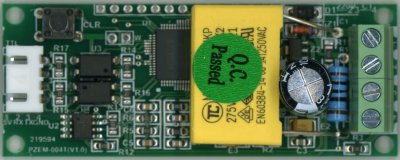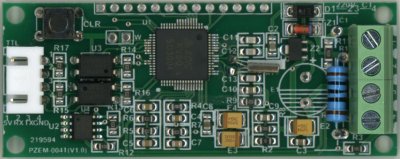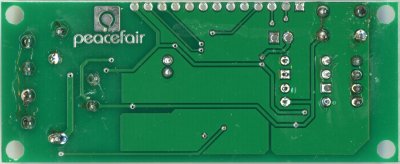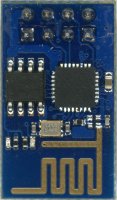This is an old revision of the document!
Table of Contents
The spark abacus is a custom electricity meter with wireless data logging capability. It's a follow-up to the spark counter for a 3-phase 4-wire mains electricity power distribution installation.
electricity meters
For the spark abacus I am using several electricity meters. This just evolved over time as I wanted to try different technologies, but one (set) of them is sufficient to complete the task.
peacefair PZEM-004T
The pacefair PZEM-004T is an inexpensive single phase electricity meter.
Connect mains electricity (AC) and the current sensing coil (put around the wire going to the load to monitor) and this electricity meter will measure voltage, current, power (active), and energy used by the load to monitor. The energy value is saved (in EEPROM) and can be reset using the button (on the board).
The device also offers a serial port (isolated from mains electricity using optocouplers) so to be able to read out the measured values. The serial protocol is the same as for the PZEM-004.
Compared to the PZEM-004 it comes without display and buzzer, but is much smaller. Else it uses the same design and chip.
EPS8266
To send the values measured by the electricity meters and collected by the micro-controller, I used a WiFi module based on the ESP8266 SoC.
Several modules based on this chip exist. Since I only use its WiFi functionality, and no other micro-controller capability, I used the simplest, smallest, and cheapest one, the ESP-01.
ESP-01
To use the device, simply connect GND, VCC (3.3V), RX (module input), TX (module output), RST (using a pull-up resistor), and CH_PD (using a pull-up resistor).
AT firmware
My module showed the following firmware information when powered up (with 9600 8N1 serial configuration): Vendor:www.ai-thinker.com Version:0.9.2.4.
When using the AT+GMR command to get the version it showed 0018000902-AI03.
This custom firmware wasn't particularly stable, so I decided to use a more recent, and standard one.
To flash a firmware you have to enter the bootloader mode by connecting GPIO0 to ground. Then you can use one of the numerous ESP flashing tools. I used esptool.
Espressif offers SDKs for the ESP chips. Since I only want to use this module for its WiFi connectivity I only care about the AT firmware. The AT firmware allows to control the ESP using AT commands over serial. This firmware is provided in the NONOS SDKs (V2.0.0 as of 2016-08-10).
The module I had uses a 25Q40 flash chip with only 4Mbits/512KBytes. You can also identity using esptool:
esptool --port /dev/ttyUSB0 flash_id esptool.py v1.1 Connecting... Manufacturer: c8 Device: 4013
As mentioned in the SDK notes: “Since the release of ESP8266_NONOS_SDK_V1.5.0, AT firmware is too large to use 4Mbit flash. Please choose flash with at least 8Mbit capacity.”
This is mainly because it is now possible to update the firmware over the air, thus there needs to be a second firmware image the main firmware can write and boot.
I was still able to flash the AT firmware provided in SDK 1.5.0 from 2015-11-27 (archive) using the “non-boot” version as described in the readme.txt:
cd esp_iot_sdk_v1.5.0/bin/at/ esptool --port /dev/ttyUSB0 write_flash 0x00000 noboot/eagle.flash.bin 0x40000 noboot/eagle.irom0text.bin 0x7e000 ../blank.bin 0x3e000 ../blank.bin esptool.py v1.1 Connecting... Running Cesanta flasher stub... Flash params set to 0x0000 Writing 28672 @ 0x0... 28672 (100 %) Wrote 28672 bytes at 0x0 in 2.5 seconds (92.0 kbit/s)... Writing 249856 @ 0x40000... 249856 (100 %) Wrote 249856 bytes at 0x40000 in 21.7 seconds (92.3 kbit/s)... Writing 4096 @ 0x7e000... 4096 (100 %) Wrote 4096 bytes at 0x7e000 in 0.4 seconds (90.5 kbit/s)... Writing 4096 @ 0x3e000... 4096 (100 %) Wrote 4096 bytes at 0x3e000 in 0.4 seconds (90.5 kbit/s)... Leaving...
Now when I ask for the firmware version using the AT+GMR command (with 115200 8N1 serial configuration) I get the following:
AT version:0.51.0.0(Nov 27 2015 13:37:21) SDK version:1.5.0 compile time:Nov 27 2015 13:57:56 OK
Here is also the AT v0.51 Instruction Set for SDK v1.5 (archive).
I wasn't able to get AT firmware from later SDKs (>1.5.0) to work though. But again, this is just if you have only 4 Mbits (512KBytes) of flash. It is now also possible to get ESP-01 modules with 8 Mbits / 1 MByte of flash, which supports more recent AT firmwares.
Orange Pi
The Orange Pi PC is a cheap $15 alternative to the Raspberry Pi 2. This single board computer (SBC) is based on an Allwinner H3 (sun8iw7p1) SoC with ARM Cortex-A7 @ 1.2GHz (often over-clocked), and 1 GB of RAM.
For this price the hardware is unbeatable, but the software support is really poor. Also only Android supports the video hardware acceleration currently. The official images are quite old (e.g. Android 4.2.2), but there are a bit newer images made available by the community:
- Android (often ROMs from other Allwinner based products), with a weird installation process
- various linux distributions
Since I'll only use it as server I decided to go with an armbian debian jessie image.
The pin header is the same as the 40-pin Raspberry Pi, but seeing the support of the OS I wouldn't rely on the hardware drivers. I am only using this SBC a cheap computer rather than hardware platform. Also, don't forget to put a heat sink on the CPU, else they will be slowed down quite often because of the high temperatures.




